
At the Center of All Beauty
Solitude and the Creative Life
کتاب های مرتبط
- اطلاعات
- نقد و بررسی
- دیدگاه کاربران
نقد و بررسی

January 1, 2020
A memoir of the author's life and a study of solitude in highbrow modern culture. Like Thoreau and many other creatives before him, Harper's contributor Johnson (English/Univ. of Arizona and Spalding Univ.; Everywhere Home: A Life in Essays, 2017, etc.) would prefer to be alone. "To use the term favored by the Trappist monk and mystic Thomas Merton," he suggests the socially uninclined be referred to as "solitaries," and he strives to reframe their stories (and his own) under society's critical eye. "Solitude and silence are positive gestures," he writes in defense of those in the world who would prefer to live alone and aim "for the cultivation of an interior life." While reminiscing on his own past, Johnson explores notions of solitude as seen in the writings of a pantheon of exalted literary and creative figures. Poems by Walt Whitman and Emily Dickinson, along with reflections on the lives of Paul Cézanne, Nina Simone, and fashion photographer Bill Cunningham, help shape this unconventional lifestyle into a "personal, particular spiritual philosophy" that will be recognizable to even the most skeptical of readers. "In the silence of my solitary walks I hear the voices of the trees. I hear them singing of a solitude that admits no loneliness," writes the author, seamlessly integrating a wealth of source material from his diverse and multifaceted cast of saintly solitaries. Beneath his scholarly efforts (and the occasional curmudgeonly aside), a tender memoir appears in pieces, delicately woven into his artists' profiles. A monastic, transcendent visit to Cézanne's studio in Aix-en-Provence suggests that particular emotional experiences can only emerge during an independent sojourn. Memories of Johnson's childhood and parents as well as stories of friends and old lovers surface during bouts of quiet research, growing from well-chosen poems, letters, and interviews into rhapsodic recollections of a profoundly full life. An erudite lesson in embracing aloneness.
COPYRIGHT(2020) Kirkus Reviews, ALL RIGHTS RESERVED.

February 24, 2020
In this stirring memoir and social critique, Johnson (Everywhere Home: A Life in Essays) explores a life of solitude of those who “sit alone writing, painting, or reading, or watching the changing light.” A self-described “solitary,” Johnson posits that he and other artists who have focused wholly on answering a calling—rather than pursuing romantic love—constitute a larger “human family.” This premise frames Johnson’s meditations on how race, celibacy, sexual orientation, or gender identity have informed many a solitary life. He investigates his “affection for being alone” through colorful anecdotes of his “bent” childhood in rural Kentucky and calls his choices to be childless and celibate “a joyous turning inward.” Johnson then examines 11 solitaries, including writers Walt Whitman and Emily Dickinson, as well as jazz singer Nina Simone, who, because of her commitmment to her art, refused to marry the one man she loved. Queerness and solitude, writes Johnson, make many of them “role models for the cultivation of an interior life.” Some, he observes, went from longing for a partner to calmly accepting solitude as a gift of destiny, while others, such as Simone, never “seemed to have reached that inner peace.” His musings on solitude deliver heady and abstract concepts with engaging clarity.

























دیدگاه کاربران